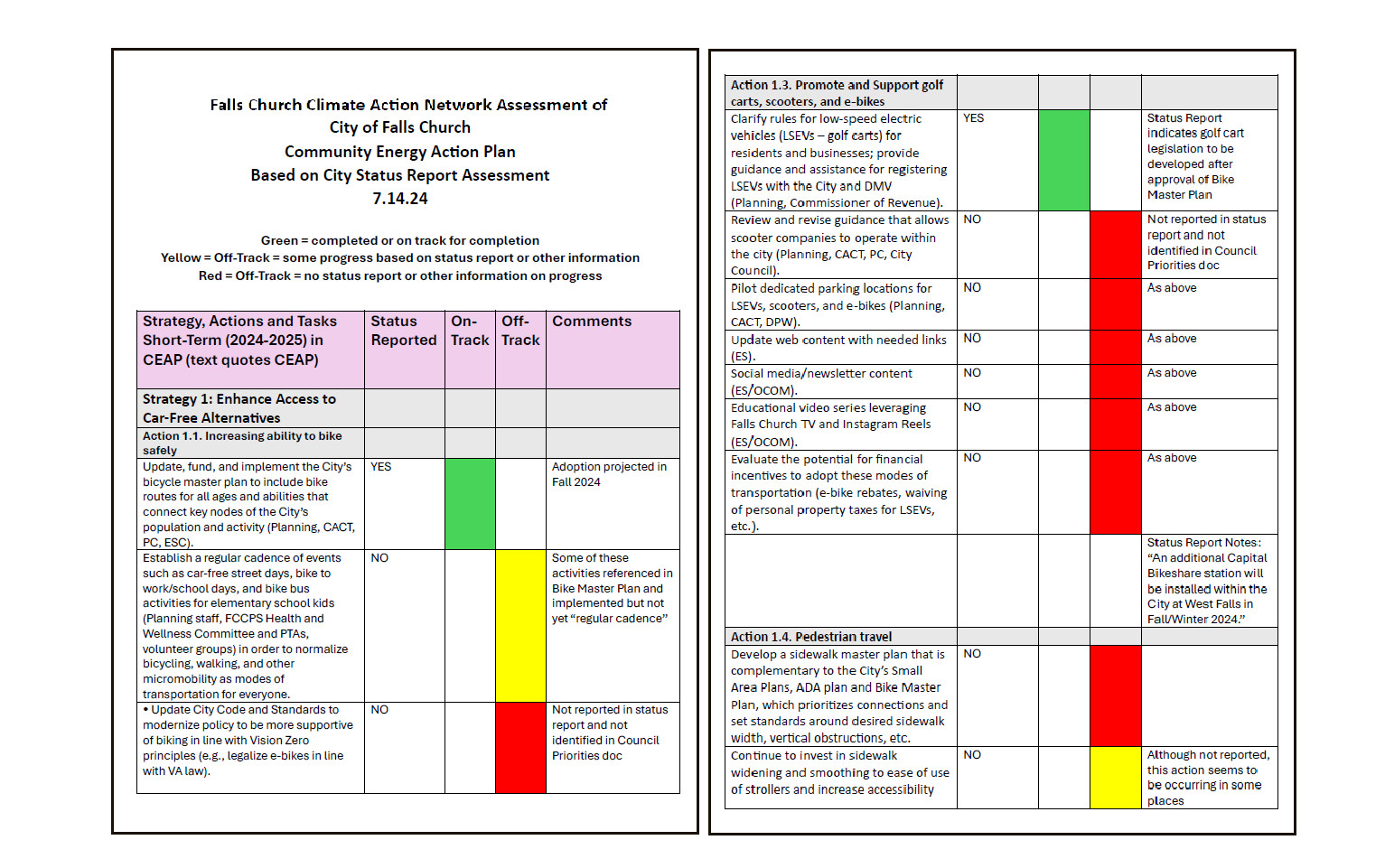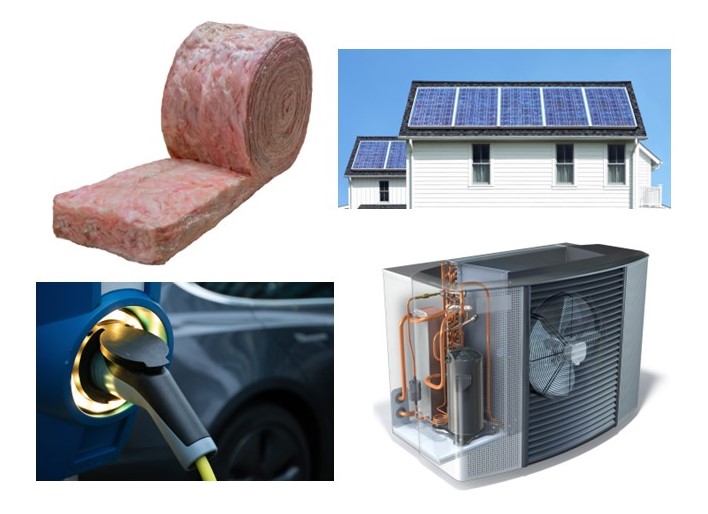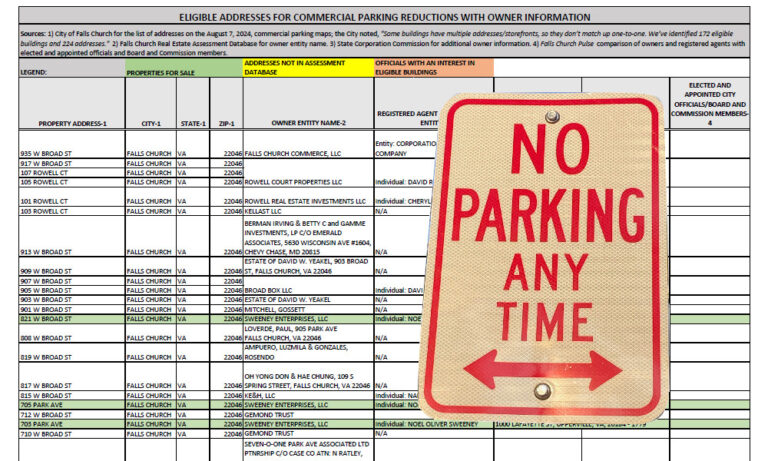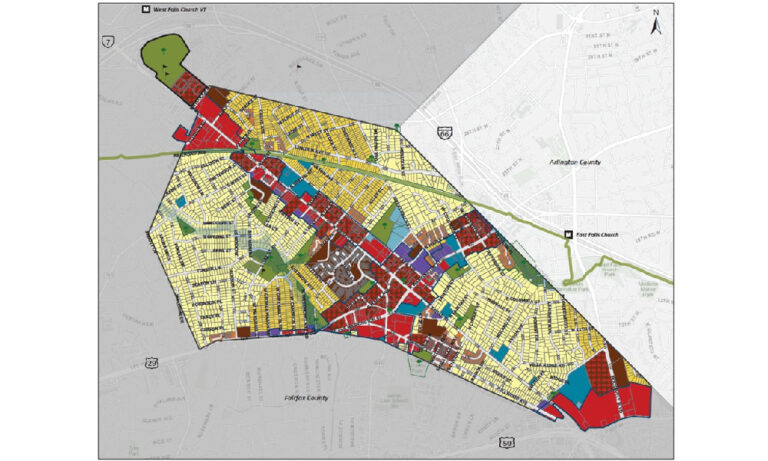The City’s Energy Action Plan: Progress Updates
By FCCAN
Editor’s note: This post is reproduced from a Falls Church Climate Action Network (FCCAN) blog with permission. For readers interested in what they can do for the City’s energy action plan, read FCCAN: New Local Group Shows How We Can Respond to Climate Change by Cutting Greenhouse Gases.
A Good News, Bad News Story
In 2023, the City of Falls Church adopted an energy and climate action plan for the community with a goal of a 50% reduction in release of fossil fuel emissions that cause climate change by 2030 and 100% (net) by 2050. To support these goals, the City also adopted a plan describing actions to change City government operations to dramatically reduce emissions, mostly by buying its electricity from renewable sources.
The two energy and climate plans mark an important new commitment by the City to take actions over the long-term to reduce fossil fuel emissions. The Falls Church Climate Action Network strongly supported adoption of the plans.
There are, however, two big-picture problems with the new energy and climate plans.
Problem #1:
The community energy plan identified pathways to achieve only a 30% reduction by 2030, rather than the adopted 50% reduction goal. The chart below helps people to visualize the relative contributions that can be expected from emissions reductions in various sectors. It also clearly illustrates that additional actions will be needed to meet the 2030 reduction goal. The City has committed to review and revise the plans in 2026, and that will be a chance to align actions with the 2030 emissions reduction goal.
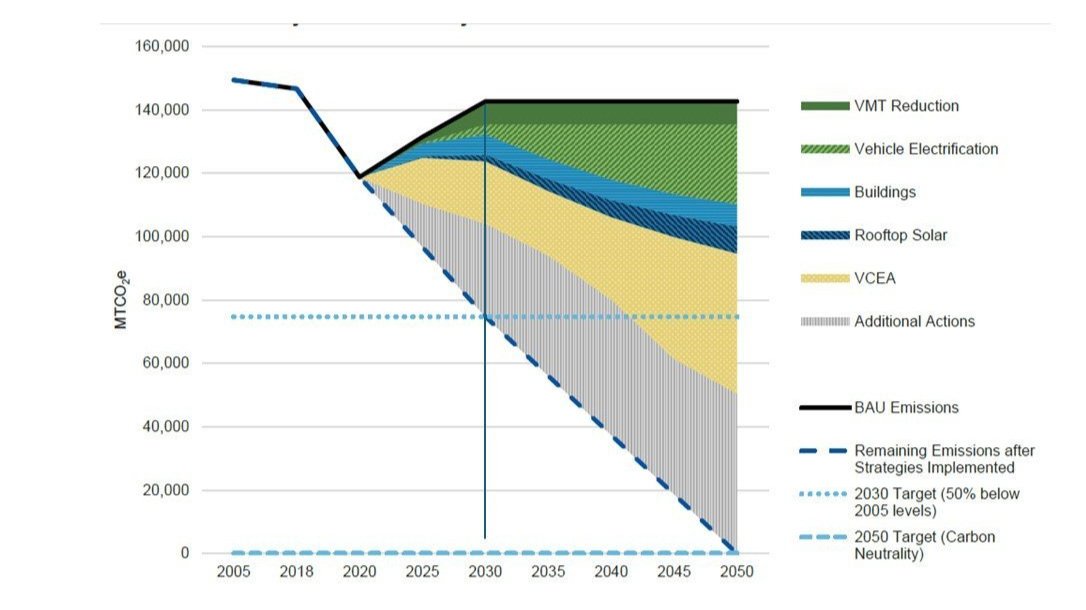
Problem #2:
Full and timely implementation of the energy and climate plans is constrained by limited funding and staff resources. The City has priorities in many areas other than energy and climate, and actions to implement the energy plans must compete for limited resources. So, a key question arises: What progress is the City making in implementing the actions described in the two energy and climate plans?
The Energy Action Plan review
In two status reports in late June, the City described work underway to implement the two energy plans. Members of the FCCAN Steering Committee reviewed the status reports and other related information and found significant progress in some areas but limited or no progress in others (i.e., good news and bad news). FCCAN hopes that this assessment can be helpful to the City in considering future investments and the public in understanding progress to date. See the City staff’s status report for the Community Plan and for the Government Operations Plan.
The Good News
Some of the good news on implementation of the energy plans includes:
1. One-Stop-Shop for Homeowners Seeking Emissions Reductions: Creation of web-based “one-stop-shop” providing the public with information about opportunities to shift from fossil fuels to electric power;
2. Bike Master Plan: Development of a Bike Master Plan, including another Capital Bikeshare Station in the City in Fall/Winter 2024;
3. Community Center Geothermal HVAC: Support for replacement of the main HVAC system at the Community Center with a geothermal heat pump system; with the current federal subsidy, the City found this to be the cheapest option;
4. Electric Vehicle Grant: Successful application for grant funds to support City purchase of 10 new electric (EV) and plug-in hybrid vehicles by September 2024 and installing 8-10 new EV charging stations at the property yard and City Hall;
5. Electric School Bus Grant and Routing: Successful application for grant funds for purchase of two new electric school buses, and progress toward a school bus route optimization study;
6. Energy Management Software: Procurement of new software to better manage the City’s use of vehicles and energy;
7. Purchase of Renewable Energy Credits: Purchase of Renewable Energy Credits (RECs) to offset 100% of general government operations and a commitment to explore purchase of RECs to cover school electricity use;
8. Solar For City Buildings Assessment: Evaluation of solar power production potential for City and school buildings, building on the success of the Meridian High School Solar Project;
9. LED Streetlight Conversion: Planned conversion of all 1,000 streetlights to LED lighting by the end of 2024; and
10. City Transparency on Energy Plan Progress: City follow-through on its commitment to provide annual reports describing implementation of both plans.
The Bad News
Although an impressive range of important actions to implement the City energy plans is underway, some important actions are behind schedule or not yet addressed. Some examples include:
1. Commercial Energy Audit Program Delays: Delays in launching the newly funded pilot program to fund energy audits for smaller commercial businesses due to a lack of interest among area audit contractors, given the small sizes of many of our commercial buildings (about 25% of our CO2 emissions are due to our commercial buildings);
2. Pedestrian Safety Delays: No reported actions to implement a range of pedestrian safety actions in the plan, including development of a sidewalk master plan and assessment of use of crossing guards to encourage kids to walk to school;
3. Property Assessment Database Delays: Delay or lack of reported progress in use of City property assessment database to track development of residential solar projects, conversions from gas to electric home and water heating, and conversion to electric stoves;
4. Residential Energy Audit Program Delays: Lack of reported progress in launching a residential energy audit program along with the commercial building audit program (about 23% of our CO2 emissions are due to our residential buildings);
5. Gas-Powered Vehicle Purchase: Purchasing 8 new internal combustion engine (ICE) vehicles and a diesel powered school bus recently after finding no practical EV alternative or finding that no hybrid options complied with mission need (these vehicles will be legacy carbon sources throughout the years of their useful life);
6. Power Purchase Agreement Delays: No reported actions to develop an RFP for a long-term contract (possibly in partnership with other jurisdictions) for a wind- or solar-Power Purchase Agreement by 2028 to achieve City government power reductions by 2030 (48% of the emissions reductions called for in the government plan come from this action);
7. City-School Coordination Delays: Work to establish a standing working group to bring government and school managers together for plan implementation and to provide quarterly status reports to the Superintendent and City Manager is behind schedule;
8. Energy Efficiency Policy Delays: Actions calling for a policy to ensure all operational improvements for facilities prioritize energy efficiency, including new lighting, appliances, and HVAC equipment are not mentioned in status reports;
9. Staff Education on Energy Efficiency Delays: Actions to develop and implement a staff engagement campaign to ensure staff understand how energy plans may impact their responsibilities and the importance of achieving the City’s Plan goals is not mentioned in status reports; and
10. Fleet Procurement Plan Delays: Work to develop a fleet procurement plan for purchases through 2030 and map out EV charging station needs is not mentioned in status reports.
Finally, it is important to note that, although the City purchased Renewable Energy Credits (RECs) to cover 100% of general government electricity use as required by the government energy plan, it did not comply with the provision of the plan stating that RECs should be “preferably located in Virginia”.
The City paid $7,000 for the right to claim 2.5 million kilowatt-hours of solar energy produced in Texas (< 0.3 c/kWhr). There, utility-scale wind and solar are already 10 times Texas’s regulatory requirement [1, 2, 3], so our buying those RECs likely does little to spur more renewables. Purchasing RECs on the Virginia grid sends a signal to the market to speed-up the installation of wind and solar power but would likely cost 4-10 times as much.
FCCAN recognizes that purchase of Virginia RECs was a preference, rather than a firm commitment, in the Plan and urges the City to consider purchase of Virginia based RECs in the future where this is cost-effective relative to other energy related investments. Development of a power purchase agreement (see #6 above) would reduce or eliminate need for RECs.
Summary Assessment of All Actions
Although the City status reports provide helpful information about implementation of energy plans, the reports do not address all the individual actions and tasks included in the plans for the “Short Term” (i.e., 2024 or 2025) in the case of the community plan or for fiscal years 2024-2025 in the case of the government operations plan. Additional actions scheduled to occur in FY 2026 and beyond are not addressed in City reporting or this assessment. “Council Priorities” are identified in the City June 24 memo on Council priorities and noted on the more detailed FCCAN assessment tables for each plan.
The tables below summarize the assessments of the FCCAN. Actions in the highlighted columns are assessments for total actions (i.e., not just actions reported on in City Status Report).
The Community Energy Action Plan (CEAP)
| Strategy | Target or Milestone |
|---|---|
| 1: Enhance Access to Car-Free Alternatives | By 2030, 20% reduction in passenger car vehicle miles traveled |
| 2: Accelerate Shift to EVs | By 2035, 100% of new passenger vehicle purchases are EV, and by 2050 100% of new medium- and heavy-duty vehicle purchases are EV |
| 3: Improve Efficiency and Electrify Our Buildings | By 2030, 13% reduction in building energy use, driven by the following actions being taken annually: – Installation of 200 to 350 air source heat pumps – Electrification of 150 to 200 water heaters – 60 homes complete whole-home efficiency improvements |
| 4: Minimize Carbon Impacts of New Development | Encourage energy efficient and low-carbon development in the City |
| 5: Increase Clean Electricity Supply | By 2030, 5% of single-family homes will have onsite solar, increasing to 20% by 2050 |
| 6: Improve measuring, tracking, and reporting of activity and emissions, and promote progress within the community | Targets for Strategy 6 not identified in CEAP |

Details in https://fccan.net/s/CEAP-Status-Assessment-June-2024.pdf
The Government Operations Energy Action Plan (GOEAP)
| Strategy 1: Increase interdepartmental collaboration and engage partners across the city and region to successfully implement the strategies in this Plan. |
| Strategy 2: Determine training required for staff to implement the fleet and facilities strategies. |
| Strategy 3: Gather, organize, and analyze energy data to track and report progress towards Plan goals and identify opportunities for impactful projects. |
| Strategy 4: Increase use of clean electricity, beginning with high quality RECs to achieve scale while the City evaluates and pursues various off- and onsite renewable energy supply options. |
| Strategy 5: Decrease energy use through the adoption and implementation of a building energy efficiency policy and the standardization of building control systems to streamline building operations and maintenance. |
| Strategy 6: Electrify heating, cooling, and cooking appliances during renovations or at the end-of-life of current systems. |
| Strategy 7: Optimize City fleet operations by right-sizing vehicle populations based on the needs of City staff and improving school bus routes to reduce fuel demand. |
| Strategy 8: Establish guidelines for centralized vehicle procurement that prioritize the purchase of low- and zero emission vehicles. |

Details in https://fccan.net/s/GOEAP-Status-Assessment-June-2024.pdf
References
- The Community Energy Action Plan. City webpage.
- The Government Operations Energy Action Plan. City webpage.

